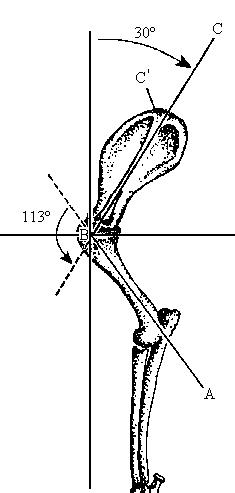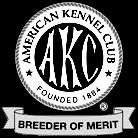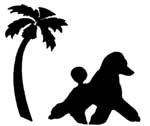|
|
|
Julie
Borst Reed |
|
u |
| u |
| Breeder
Ethics Questionnaire |
| u |
| Puppy Comes Home |
| u |
| u |
| Puppy Temperament Testing |
| u |
| Recommended Diet |
| u |
| FAQs
About Feeding Raw |
| u |
| REAL Dog Food |
| u |
| Fleas 101 |
| u |
| Standard
Poodle Health Concerns |
| u |
| Recommended Vaccination Schedule |
| u |
| Vaccination Decisions |
| u |
| Neutering |
| u |
| Photo Gallery |
| u |
| A Breeder's Life |
| u |
|
Interview
with Dog Breeders' Guild |
| u |
| Poodle Funnies |
| u |
| Tiara Home |
| u |
| u |

|
|
|
PROPER
SHOULDERS FOR THE POODLE BREED
– Julie Borst Reed
“Strong,
smoothly muscled shoulders. The shoulder blade is well laid back and
approximately the same length as the upper foreleg. . . Major Fault: Steep shoulders.”
- from the AKC Poodle Breed Standard 1990.
The
Stud Dog Issue is the perfect setting to open a discussion about a common
problem seen in our breed: steep shoulders. It
is this time of year that many Poodle breeders anxiously shop these pages
and the rings at PCA for their next stud dog.
Shopping is fun – most agree! From
what I have heard recently, the hunt is on for good shoulders.
I
want to ask, is the steeper (straighter, more upright) shoulder occurring
because we want the dogs to present as being squarely built?
Poor shoulders are readily observed in poor jumping style and
easily noted in the performance dogs.
A bunny hop to launch and then a stilted landing is indicative of
steep shoulders in agility competition.
For the conformation ring, fanciers are easily able to train their
eye for good shoulder construction by studying slow motion video of dogs
moving at a trot. Flying legs, with high action is usually indicative of poor
conformation. Where and with
what timing the feet strike the ground tells so much and slow motion tells
just about all. The further
details you must feel to be certain and an article I present below will
skeletally illustrate the details.
Currently,
I have a male that has matured and developed the most wonderful,
exceptional chest, shoulder, neck and rib assembly.
The problem is, especially for the standard variety of poodle, when
you get all those beautiful front angles in balance, you begin to lose
length of leg (and sometimes neck). He’s
got the neck, but oh, where are the legs we all love on the
squarely-appearing outline?
The
square appearance is at best “hanging on” in Poodles that I have noted
with great fronts. I am not
writing about the good dog that is balanced front and rear, as often those
shoulders are not the finest to be found. That coming together of great
front end and elegant, tall, “apparently” square Poodle happens so
rarely. Not to be
discouraged, as many of you know that it does occur and if the measurement
is truly squarely built with great shoulders, well that is even rarer and
please tell all about this Poodle!
There
is not to be a difference among the varieties in conforming to the breed
standard (conformation). Except
for height, all is expected to be the same proportion.
Is it my experience only, or do the fronts seem better lately on
the two smaller varieties and does it seem easier to locate mates to
produce good spring of rib and excellent shoulders on a Miniature
(especially)? Could
measurements be given for particular conformation aspects of the dogs
offered at stud in the future?
Interesting to contemplate what the fanciers could request to know
in deciding on pairings, especially if computer imaging comes into play.
Educating
about the anatomy of a superb front will help many fanciers to more easily
grasp the balance of fore and aft. Rears
in Poodles seem to have improved immensely over the last thirty years. The following article and links will help to educate fanciers
to appreciate a front worth developing in a breeding program. Much
about conformation can be determined by watching a dog move. Additionally,
understanding the basic skeletal structure provides the insight needed to
correctly interpret what you feel as you go over the dog.
This
particular dog I mentioned above isn't the “IT” dog I am reworking my
pedigrees to achieve, that is probably still years away. Yet, I plan to
utilize him and I am tempted to let judges use him as a comparison in a
lineup, just to see their expression when they feel his front end!
My
favorite explanation of shoulder assembly follows, primarily due to the
good pictures and excellent, easy to follow analogy.
http://bowlingsite.mcf.com/Shoulder.html
Measuring
Shoulder Angulation
By Sue Ann Bowling
Shetland Sheepdog Fancier, North Pole, AK
Edited by Kirk S. Reed, Tiara Std Pdls, California
Figure
1 shows the parts of the shoulder assembly itself. The skeleton shown is a
commercially articulated one, and it looks as if the upper arm was mounted
at a far more extreme angle than the dog would have had in life; when the
parts of the skeleton were held together by muscles and ligaments.
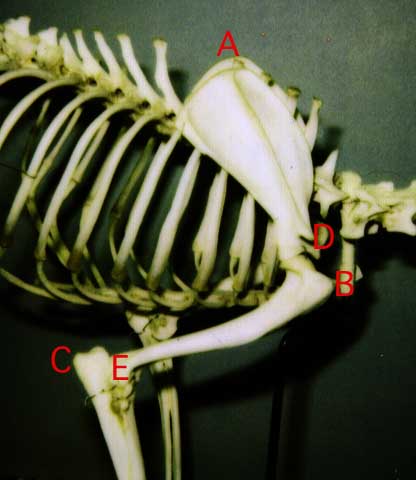
Figure
1
A
is the top of the scapular ridge. D is the lower end of the
scapula. The distance from A to D is the length of the
scapula (shoulder blade.) This line follows the scapular ridge, and
according to some authorities defines the shoulder angulation, as shown in
figure 2.
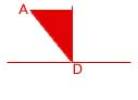
Figure
2
The
angle inside the shaded triangle at D
in Figure 2 shows where the shoulder angulation is measured. A 30 degree
angle has a more upright scapular ridge than does a 45 degree angle.
The
length of the humerus, or upper arm, is correctly speaking the distance
from B to E.
In
practice, E is difficult to find in a living dog, though it is
obvious enough on a skeleton. The scapular ridge is also covered with
muscle in a healthy dog, and can be very difficult to find if the dog is
on the plump side.
The
point of shoulder, B, is quite easy to locate on a live dog, as is
the elbow, C. As far as length is concerned, the measurement from A
to B is equal to that from A to D plus the thickness
of the humerus; that from B to C is equal to that from B
to E plus the thickness of the upper ulna (the longer of the two
bones making up the lower arm.) If the thicknesses of the humerus and the
ulna are similar, Then comparison of AB with BC will give
very similar results to comparing AD with BE.
The
Sheltie standard does not actually give a correct length for the upper
arm. It asks for a 45 degree slope to the shoulder and a 90 degree angle
between the shoulder blade and the upper arm. This requires that the upper
arm also have an angle of 45 degrees from the vertical, but says nothing
about length. Leon Hollenbeck's book, Dynamics of Canine Gait,
agrees with Rachel Page Elliot's book, Dogsteps, in
suggesting that the ideal for an all-around dog is for the scapula and the
humerus to be approximately equal in length.
If
the bones are equal in length and the angle between them is 90 degrees, we
can use the Pythagorean formula to get the vertical distance AC
as shown in Figure 3.
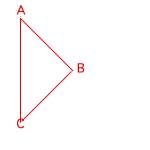
Figure
3
Remember
"The square of the hypotenuse equals the sum of the squares of the
other two sides" (AB2 + BC2 = AC2).
Because AB and BC are the same, we can state that in the dog
with shoulder blade and upper arm equal and a 90 degree angle between
them, the distance from the withers to the elbow should be 1.414 (the
square root of 2) times the distance AB. AC is somewhat difficult to measure, for two reasons. First, the dog
can vary this length by opening and closing the shoulder angle, which is
the major reason height, is inexact. An excited stud dog will "stand
tall", with the angle at B
opened as far as possible and the angulation reduced. A very relaxed,
slouching dog (or a border collie approaching sheep) will have the angle
of the shoulder closed by gravity, and will appear to have more angulation.
Also, the measurement has to go around the curve of the dog's side.
I
don't have a good reason, aside from assuming that the foreleg scales to
the overall size of the dog and is proportional to the length AC,
but I have found that my best movers have had very nearly the same length
of forearm as the shoulder and upper arm length. Forearm length is shown
as the distance CF in Figure 4.
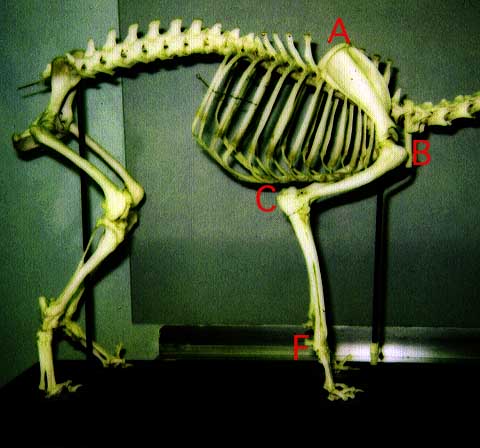
Figure
4
Note
that the forearm measurement is from the point of the elbow to the
little projection at the back of the pastern joint, just above the
carpal ball. My best moving dogs have had AB, BC and CF
approximately equal in length, or with CF slightly longer. If CF
is much longer, the shoulder blade and upper arm will generally be too
upright, even if they are the same length. Many of the Shelties I have
measured at shows have had BC an inch or more shorter than AB.
Further comments from JBR
Thanks
to Sue Ann Bowling for her permission to reproduce the article above and
to my husband, Kirk S. Reed, editor of the article for inclusion here.
And yes, very few Poodles have the balanced AB/BC
measurements as Sue has noted in Shelties; I have known a few Poodles with
those balanced measurements and they were very effortless in movement both
in trotting and jumping. Often
too, a square appearing Poodle outline has the
CF much longer than AB/BC
measurements and that is when we see the upper arm become more upright.
It is certainly an intricate design challenge for conscientious
Poodle breeders to produce the best front, conforming to the standard for
endurance and proper active dog ability, coupled with the square outline
so desired in our wonderful breed.
I
hope that this information has given much food for thought.
Shetland Sheepdogs and Poodles are understood not to have
identical structure, but they each require an “effortless”,
ground-covering trot with rear drive noted.
The front, I must add, has to be capable of handling the drive!
Each of these breeds is desired to exemplify sure-footed
agileness. The
wonderful opportunity to share the pictures of the skeleton, along with
discussion by Sue Ann Bowling has been a privilege of mine and I want to
thank her again, as well as my husband for editing the article.
To note, the dog skeleton in the pictures is of unspecified
breed. The article above was submitted to assist in discussing
the skeleton of the front end assembly.
Additionally,
I want to thank Fred Lanting for permitting the inclusion of this
wonderful drawing depicting 30 degree shoulder angulation, which further
explains the Figure 2 in Sue Ann Bowling’s article (although shown
here with shoulder facing in the opposite direction and different
letters assigned the components).
This
drawing is in the popular book, The
Total German Shepherd Dog, by
Fred Lanting (Hoflin
Publishers). There is an
excerpt of this book concerning shoulder construction
on-line at: http://siriusdog.com/articles/anatomy-working-canine-dog-shoulder.htm
